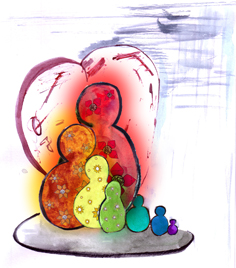
The Many Peaces Trilogy
The Many Peaces trilogy, published first in German between 2008 and 2015, then in English translation between 2012 and 2018. Its epilogue in a separate volume of 2021 (so far only in German) traces the development from the initially postmodern concept of many peaces via transrational peace philosophy and elicitive conflict transformation to the praxis of elicitive conflict mapping.
The epilogue has been written instead of a revised and actualized new edition of the original volumes. It completes the step from many peaces to peacing as activity and proceeding in the frame of an immanent worldview.

Volume 1 (2012) is titled in English Interpretations of Peace in History and Culture. It grounds principally in postmodern philosophy as proposed by Jean Francois Lyotard or Richard Rorty and by Clifford Geertz‘ interpretive ethnology. Most of all it roots in humanistic psychology after Abraham Maslow and Carl Rogers. It deals first with the interpretation of the term peace in different historic and cultural contexts from ancient to present times. In the frame of this post-structural `archeology´ selected notions of peaces from all continents are considered. The book structures these selected examples in five principle groups of interpretations. Nonchalantly it calls them “peace families”: the energetic, the moral, the modern, the postmodern and the transrational.
This synopsis is followed by the elaboration of the so called transrational approach. This was in its time highly innovative for the discipline. It did not exalt any of those peace interpretations in whatsoever civilizing pretense over the others. It rather took every interpretation serious that has been or still is communicated in social realities. Further, transrationality acknowledges all achievements of scientific research. And it considers all aspects of the human, all too human nature beyond mere reason as relevant if it comes to perception, understanding, feeling, living and experiencing peace in human relations and beyond. The peace has neither cause nor goal. The meaning of peace is peacing.

Volume 2 (2013) deals with Elicitive Conflict Transformation and the Transrational Shift in Peace Politics. The artificial term elicitive has been coined by John Paul Lederach in the 1990ies. By that he meant an approach to applied conflict work, which expects the transformative energy of conflicts within the direct relation of the involved parties. Therefore the responsibility of third sides is the provision of save spaces and appropriate structures of communication. It is . not yielding their own expertise as what so ever pacifiers. Lederach discriminated elicitive conflict transformation from prescriptive conflict resolution. In resolution the initiative, the expertise and the model of the mediator play the central role. From the different approaches to conflict work and its agenda, from the different understanding of the role of the parties and of conflict per se result considerable divergent methods of applied conflict work.
Elicitive conflict transformation is the practical consequence of transrational peace philosophy. This volume traces this paradigmatic turn in interpretation and application. The examples of diplomacy, of military peace operations, of development cooperation and economy are discussed in detail.
Elicitive conflict transformation as an international praxis demands specifically trained personnel. Therefore, this volume deals (only in its German original edition) also extensively with the curricular and didactical requirements for a tailor-made academic study and training for elicitive conflict work. More on this topic in English can be found in Transrational Perspectives in Peace Education.

Volume 3 (2018) of the trilogy is on Elicitive Conflict Mapping (ECM). It builds on the philosophical principles and the methodical-didactical considerations of the previous volumes. This third one develops in Elicitive Conflict Mapping a practical tool of applied conflict work. This takes as much from Abraham Maslow’s hierarchy of needs as from Marshall Rosenberg‘s non-violent communication, Tony Buzan’s mindmapping, John Paul Lederachs conflict pyramide, Carl Rogers’ client-centered therapy and even from the Continental Staff System as organizational scheme of military and quasi-military structures in civilian peace work. Most of all, of course, it builds on elicitive conflict transformation as principle of work.
ECM is nothing but a tool. It does not pretend to be anything else. That is, it is an option for practical conflict work. It is no truth, no way, and no norm. It is available where it can be applied in a meaningful and beneficial way. Logically, this will be mostly the broader context of elicitive approaches.
In the first part of this book, the method is deduced from older ones. They are established and described in order to make its application understandable from individual intra-personal via relational inter-personal conflicts to the big political arena in all its contexts.
In the second part of the book, the method gets tested. This happens with the help of concrete learning examples that have been taken from well known pieces of theatre, film and literature in a way that allows the reader to try these examples in his or her own way.

The epilogue followed the Many Peaces trilogy under the German title Der die das Frieden as a separate small book. It provides updates and completions to the previous volumes of the trilogy. More than anything, this volume calls for a shift from the subject-oriented speech in peace research towards an activity- and proceedings-oriented language. It reasons this call with the identification of subject-orientation as a compulsory tool of domination in all modern European grammars since ancient Greek. This has been serving and still is serving the colonial subjugation of non-European contexts.
Action- and proceeding-oriented grammars are used naturally in many important, old and big languages on all continents outside Europe. In these languages one can say in a grammatically correct way that it peaces. This can concern social contexts between and among individuals as much as relations of groups. However, it even regards the interaction between the human kind and the nature around it and all circumstances and processes in the very nature.
Grammar limits our thinking of the world by solid boundaries. A changed application of grammatical rules can open new doors of perception for understanding and acting. The staccato of serious crises in the fields of social, environmental, educational, alimentation or medical politics – not only – on the European continent invites to transgress the limited horizon of subject-oriented speech of the peace.
Peace, does not come from mere claiming, but only if we do it!. This sung Austrian poet André Heller already in 1982 for the German peace movement of that time in his epilogue,[1] ,
Four decades later, the epilogue to the Many Peaces trilogy states that possibly it peaces only if we allow, perceive and do it.
[1] Heller, Andre: Stimmenhören [EMI Electrola GmbH, Wien, LP 7-92246-1/ CD 7 92246 2] 1982.